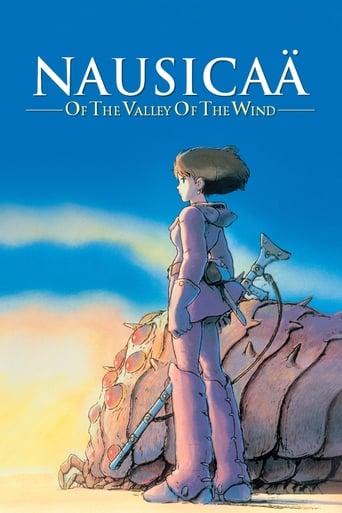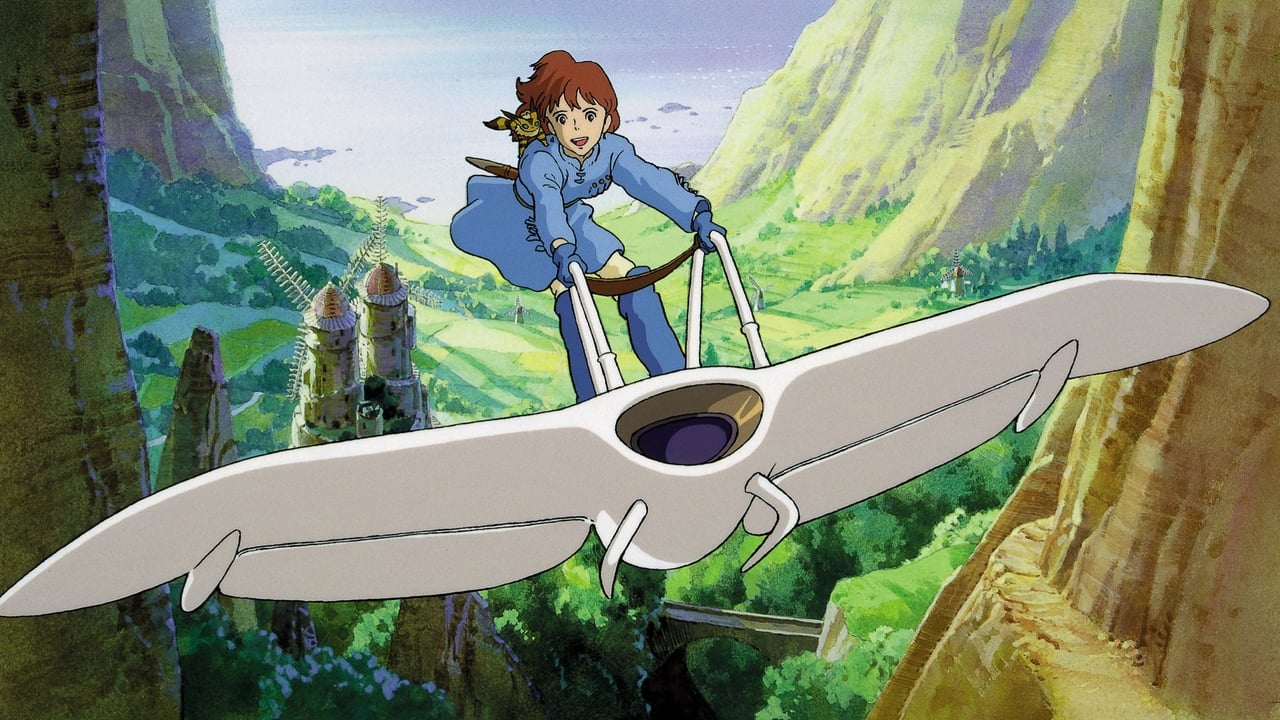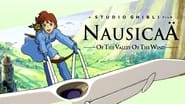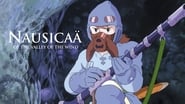Will K
This is a film that has stood the test of time. It is nearly perfect. The story is one that is truly relevant, detailing the fight man faces against mother nature, and the drawbacks of the longevity of the fighting. The story is one we can all learn from, and is truly thought provoking. The score is incredible, truly fits the film and is such a pleasure to listen to. It is a beautiful film to look at and it's hard to believe that it was made in '84. This is another one in the basket for Ghibli. Truly remarkable.
ElMaruecan82
The name of Nausicaä belongs to Greek mythology; she was the Princess who saved Ulysses from drowning. And the "Valley of the Winds" was loosely inspired from the tragedy of Minimata Bay and the way it maintained its ecosystem viable despite the pollution. "Nausicaä of the Valley of the Winds" finds the perfect balance between the theme of nature always finding its way and the dramatic struggle of a heroine saving humanity from "drowning" in belligerent wickedness.I'm mentioning Minimata but the tragedy of Fukushima could have inspired a similar intuition that technological advances could only lead to the downfall of humanity inasmuch as men continue to display the same carelessness and arrogance. In his "Nausicaä", Hayao Miyazaki doesn't warn us but rather confronts us to a plausible future, a future with a few survivors driven to the last corners of Earth where wind and water prevented a toxic jungle name Fukaï from spreading.The film, all in visual splendor, displays the usual Sci-fi and Fantasy archetypes but they don't distract from the environmentalist and pacifist message. We accept them in the sense that the story is set one thousand years after the apocalypse and we expect technology to have produced jet-propelled gliders and flying vessels. But the film also has a Renaissance look à la "Princess Mononoke", it's not an artistic license, the privileged people of the Valley represent a wiser side of humanity that got back to the roots, acknowledging the eminence of nature, a renaissance indeed.They live in an oasis-like area where the air is breathable, outside; they must wear a gas mask, accentuating the dystopian look even within a natural setting. The hostility of nature is symbolized by giant mutant insects and the Ohm, armored trilobite-like insects whose eyes turn to an ominous red whenever they feel threatened. But Miyazaki never lets us get the wrong idea about these Ohm, understand they're not the most life-threatening creatures out there.There's a key scene right in the beginning where a little fox-like creature bites Nausicaä, she patiently keeps her finger until its frenzy fades out and then the animal licks her wound. This moment is pivotal because it highlights the real tragedy that caused men's downfall, not violent actions but immediate assumptions of violence causing bad reactions. Only Nausicaä is capable of showing mercy and empathy toward any living creature, she challenges all the common conceptions and even tries to understand the place she lives in, which is the epitome of wisdom.From the spores taken during regular expedition, she discovers in her laboratory that plants are capable of producing air, later in the film that some jungle plants purify the polluted topsoil and produce clean water. In other words, life always finds a way but humans can't see it. Nausicaä becomes the messianic character that will open the eyes of humanity, and as truth can be stranger than fiction, she's also a pivotal moment in Miyazaki's career, as the first film to have emerged from the fertile soil of his own imagination.Nausicaä foreshadows all the elements that will define his work: the independent free-spirited heroine, the aerial settings and the environmental and anti-war messages, and more than that, the revolutionary notion that you don't need villains to make a story. Everyone is imperfect and fallible, even the most violent attacks are meant as defensive moves or precautions. The film contains a lot of action, lethal explosions and battles, people die by the sword, including Nausicaä's but Miyazaki couldn't have been more pacifists, every detail says in subtext that violence isn't the answer.Indeed, how can the cause of the trouble ever be the solution? Miyazaki, a master storyteller, delivers crucial information even in the most unnoticeable moments, even the opening credits show through Roman mosaic and medieval tapestry the fate of the modern world. Seven giants launching immense fire blasts (metaphor for nuclear power?) into modern buildings, it's just as if Hiroshima was depicted like the Pompeii eruption. But what is the tragedy exactly, that history taught men a lesson or that men didn't learn it? Nausicaä is set at a time that looks like a second chance but people are still fighting for good or bad reasons, from a sword master and father-figure named Lord Yupa, a young Pejite interceptor who respects Nausicaä's actions and the Tolmekian queen who (like Lady Eboshi from "Mononoke") is perhaps the tumultuous counterpart to Nausicaä, mutilated by the creatures, she believes in violence as the language of the force, illustrating its dangerously communicative effect, the never-ending spiral that killed the world
or that might lead to a third worldwide conflict.And in the midst of nihilistic violence and desolation, Nausicca emerges as a beautifully inspirational heroine. There's a hypnotic flashback (with a so-catchy playful tone) where Nausicaä's father kills a baby Ohm, on the basis that human and insects can't live together. The whole conviction of Nausicaä is that every creature has its place on Earth; it's not just about empathy but the unshakable faith on Nature's equilibrium. It is very significant that the most beautiful images from the film, all in golden yellow, are provided by the Ohm's tentacles, weren't they supposed to be the ugly monsters? Yet, at the time of its release, the film was badly edited for foreign audiences and lost into translation to become some Manga adventure in the air, and the Ohm were indeed hostile creatures. It's just as if Miyazaki was ahead of his time and it would take one decade and half before people would come back to their senses and realize that this isn't "Flash Gordon". Nausicaä is about conviction and goodness, pacifism and environmentalism deprived from any political innuendo.Miyazaki drew the original Manga so the film could be made, showcasing as much confidence as his heroine. In a way, Miyazaki was the Nausicaä of animation, a man with a vision, spirit and guts.
paystchr
In 1984, Hayao Miyazaki released this awesome movie. In 1985, unfortunately, a studio heavily edited the film, and until 2005, it was the only copy of the film with English dubbing. But thanks to Disney, Nausicaa can now be enjoyed in its original story, timeless yet powerful. 1,000 years after an event where giant warriors incinerated the Earth, a toxic jungle spreads, threatening the survival of humanity. A young warrior/pacifist/princess Nausicaa, loves to explore this toxic jungle. Then, one night, a ship crashes by the kingdom, and a giant warrior embryo is onboard. Another kingdom then takes over the valley, and Nausicaa is taken hostage. In a turn of events, Nausicaa finds a secret under the jungle, and must stop the Tolmekians from destroying it. The film is a well put together film. The animation stands out very well, and the film is awesome. The film is a visual masterpiece. It is perfect. It had me captivated from start to finish. My highest rating, goes to Nausicaa.
Johan Dondokambey
I can directly tell that this is a great movie indeed. The Japanese are great people in designing fantasy worlds. I like how the world has so great diversity in contrast. Anyone versed enough in movies can immediately spot the things that gave ideas to other movies. I see this movie's influence on Avatar (the ship design, the plants design, the forest design), Attack on Titan (the Titan's own design), and even Starship Troopers (the whole insects theme, and the ohmu's design on the brain bug). The story is unfortunately is a straightforward a children's story of good versus evil with minor twists here and there. There it's very much predictable. I saw the original version with Japanese voice, adding adequate authenticity to the experience.



 AD
AD

















